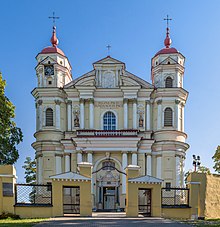St. Peter and St. Paul's Church, Vilnius
| St. Peter and St. Paul's Church Šv. apaštalų Petro ir Povilo bažnyčia |
|
|---|---|

Front view of the church
|
|
| Basic information | |
| Location | Vilnius, Lithuania |
| Geographic coordinates | 54°41′38″N 25°18′22″E / 54.694°N 25.306°ECoordinates: 54°41′38″N 25°18′22″E / 54.694°N 25.306°E |
| Affiliation | Roman Catholic |
| District | Antakalnis |
| Country | Lithuania |
| Year consecrated | 1701 |
| Status | Active |
| Patron |
Saint Peter Saint Paul |
| Architectural description | |
| Architect(s) |
Jan Zaor Giovanni Battista Frediani |
| Architectural style | Baroque |
| Funded by | Michał Kazimierz Pac |
| Groundbreaking | 1668 |
| Completed | 1701 |
| Specifications | |
| Direction of façade | Southwest |
| Capacity | 980 |
| Height (max) | 16.4 metres (54 ft) |
| Dome(s) | One |
| Dome height (inner) | 39 metres (128 ft) |
| Spire(s) | Two |
| Spire height | 24 metres (79 ft) |
| Materials | Clay bricks |
St. Peter and St. Paul's Church (Lithuanian: Šv. apaštalų Petro ir Povilo bažnyčia, Polish: Kościół św. Piotra i Pawła na Antokolu) is a Roman Catholic church located in the Antakalnis neighbourhood of Vilnius, Lithuania. It is the centerpiece of a former monastery complex of the Canons Regular of the Lateran. Its interior has masterful compositions of some 2,000 stucco figures by Giovanni Pietro Perti and ornamentation by Giovanni Maria Galli and is unique in Europe. The church is considered a masterpiece of the Polish-Lithuanian Commonwealth Baroque.
The foundation of the first church in this location is unknown. While digging the foundations for the present-day church, workers found a sculpture of an unknown knight. That inspired a legend that the first wooden church was founded by Petras Goštautas, a legendary ancestor of the Goštautai family, well before the official conversion of Lithuania to Christianity by Jogaila in 1387. More likely, the church was founded by Wojciech Tabor, Bishop of Vilnius (1492–1507). The wooden church burned down in 1594 but was rebuilt in 1609–16. In 1625, Bishop Eustachy Wołłowicz invited Canons Regular of the Lateran. Their new monastery was officially opened in November 1638.Bishop of Samogitia Jerzy Tyszkiewicz gifted a painting of Blessed Virgin Mary of Mercy (Lithuanian: Švč. Mergelė Marija Maloningoji) to the church and the monastery. The painting was brought by Tyszkiewicz from Faenza, Italy around 1641–47, and depicts Our Lady of Graces, patron of Faenza. Even though it was not canonically crowned, it was covered in silver riza and attracted votive offerings.
...
Wikipedia
